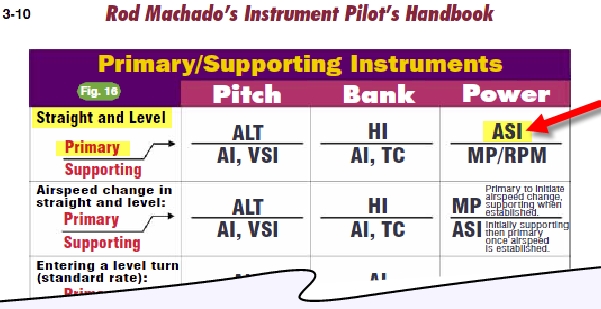eetrojan
Pattern Altitude
I've been reading numerous sources, but am still struggling to find a definitive difference between the "control & performance" and "primary & supporting" concepts.
Here's my potentially incorrect attempt to describe the process of using both methods for maintaining straight & level flight, and it sounds like they're just different ways of saying exactly the same thing.
Under control/performance, I start with the AI and use just it to select/maintain an attitude (pitch and bank) that in combination with my power setting I correlate with constant-altitude, wings-level flight, and then I cross-check the performance instruments to make sure I’m getting the desired performance, maintaining present control forces if all is good, or making smooth adjustments if required. Presumably, this cross-check would involve my checking the ALT, HI, and ASI gauges.
Under primary/supporting, I start by mentally dividing my current task at hand into pitch, bank, and power, and starting with my AI at the heart of the scan, radially cross-check my “primary” pitch instrument (ALT), bank instrument (HI), and power instrument (ASI), maintaining present control forces if all is good, or making smooth adjustments if required.
Color me confused... Using the AI and then checking the "performance" instruments (ALT, HI, and ASI), seems pretty darn close to using a succession of "primary" instruments (ALT, HI, and ASI) with the AI at the "heart" of the scan/cross-check. The "heart" of the scan language comes from Machado's books, and my own school's syllabus.
Am I missing something? Any help?
Maybe a difference would be more apparent in a more transitional phase of flight?
It seems like it may be subtle matter of philosophy? One is more holistic and the other more granular?
Here's my potentially incorrect attempt to describe the process of using both methods for maintaining straight & level flight, and it sounds like they're just different ways of saying exactly the same thing.
Under control/performance, I start with the AI and use just it to select/maintain an attitude (pitch and bank) that in combination with my power setting I correlate with constant-altitude, wings-level flight, and then I cross-check the performance instruments to make sure I’m getting the desired performance, maintaining present control forces if all is good, or making smooth adjustments if required. Presumably, this cross-check would involve my checking the ALT, HI, and ASI gauges.
Under primary/supporting, I start by mentally dividing my current task at hand into pitch, bank, and power, and starting with my AI at the heart of the scan, radially cross-check my “primary” pitch instrument (ALT), bank instrument (HI), and power instrument (ASI), maintaining present control forces if all is good, or making smooth adjustments if required.
Color me confused... Using the AI and then checking the "performance" instruments (ALT, HI, and ASI), seems pretty darn close to using a succession of "primary" instruments (ALT, HI, and ASI) with the AI at the "heart" of the scan/cross-check. The "heart" of the scan language comes from Machado's books, and my own school's syllabus.
Am I missing something? Any help?
Maybe a difference would be more apparent in a more transitional phase of flight?
It seems like it may be subtle matter of philosophy? One is more holistic and the other more granular?
Last edited:


